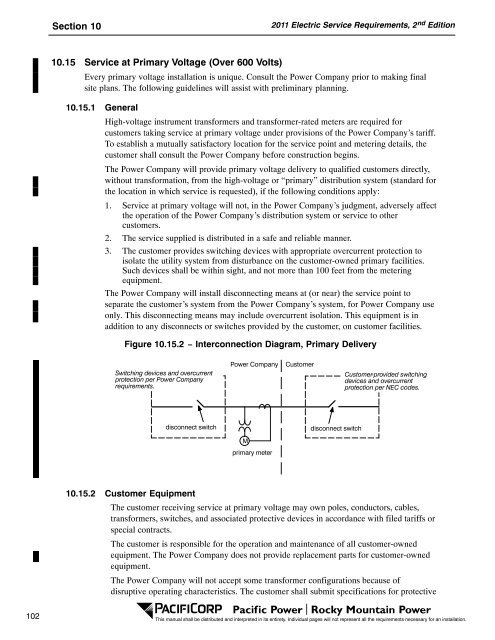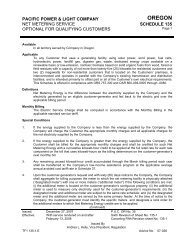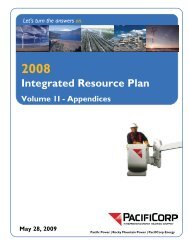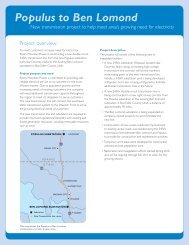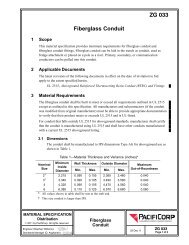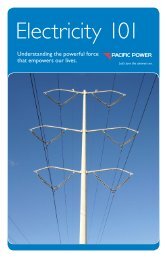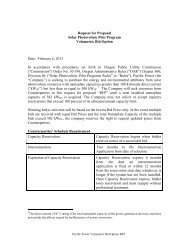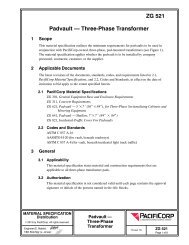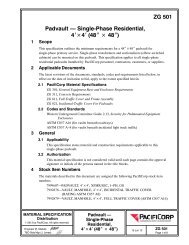2011 Electric Service Requirements Manual, 2nd - Pacific Power
2011 Electric Service Requirements Manual, 2nd - Pacific Power
2011 Electric Service Requirements Manual, 2nd - Pacific Power
You also want an ePaper? Increase the reach of your titles
YUMPU automatically turns print PDFs into web optimized ePapers that Google loves.
Section 10<br />
<strong>2011</strong> <strong>Electric</strong> <strong>Service</strong> <strong>Requirements</strong>, 2 nd Edition<br />
10.15 <strong>Service</strong> at Primary Voltage (Over 600 Volts)<br />
Every primary voltage installation is unique. Consult the <strong>Power</strong> Company prior to making final<br />
site plans. The following guidelines will assist with preliminary planning.<br />
10.15.1 General<br />
High-voltage instrument transformers and transformer-rated meters are required for<br />
customers taking service at primary voltage under provisions of the <strong>Power</strong> Company’s tariff.<br />
To establish a mutually satisfactory location for the service point and metering details, the<br />
customer shall consult the <strong>Power</strong> Company before construction begins.<br />
The <strong>Power</strong> Company will provide primary voltage delivery to qualified customers directly,<br />
without transformation, from the high-voltage or “primary” distribution system (standard for<br />
the location in which service is requested), if the following conditions apply:<br />
1. <strong>Service</strong> at primary voltage will not, in the <strong>Power</strong> Company’s judgment, adversely affect<br />
the operation of the <strong>Power</strong> Company’s distribution system or service to other<br />
customers.<br />
2. The service supplied is distributed in a safe and reliable manner.<br />
3. The customer provides switching devices with appropriate overcurrent protection to<br />
isolate the utility system from disturbance on the customer-owned primary facilities.<br />
Such devices shall be within sight, and not more than 100 feet from the metering<br />
equipment.<br />
The <strong>Power</strong> Company will install disconnecting means at (or near) the service point to<br />
separate the customer’s system from the <strong>Power</strong> Company’s system, for <strong>Power</strong> Company use<br />
only. This disconnecting means may include overcurrent isolation. This equipment is in<br />
addition to any disconnects or switches provided by the customer, on customer facilities.<br />
Figure 10.15.2 − Interconnection Diagram, Primary Delivery<br />
Switching devices and overcurrent<br />
protection per <strong>Power</strong> Company<br />
requirements.<br />
<strong>Power</strong> Company<br />
Customer<br />
Customer‐provided switching<br />
devices and overcurrent<br />
protection per NEC codes.<br />
disconnect switch<br />
disconnect switch<br />
M<br />
primary meter<br />
10.15.2 Customer Equipment<br />
The customer receiving service at primary voltage may own poles, conductors, cables,<br />
transformers, switches, and associated protective devices in accordance with filed tariffs or<br />
special contracts.<br />
The customer is responsible for the operation and maintenance of all customer-owned<br />
equipment. The <strong>Power</strong> Company does not provide replacement parts for customer-owned<br />
equipment.<br />
The <strong>Power</strong> Company will not accept some transformer configurations because of<br />
disruptive operating characteristics. The customer shall submit specifications for protective<br />
102<br />
This manual shall be distributed and interpreted in its entirety. Individual pages will not represent all the requirements necessary for an installation.


